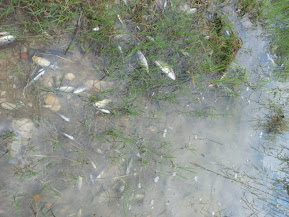Kitwe, Zambia. In February 2025, a catastrophic collapse of a tailings dam owned by the Sino‑Metals Leach copper mine near Kitwe released approximately 50 million litres of acidic mining waste into the Mwambashi River—a tributary feeding the Kafue River basin—the lifeblood of over 60% of Zambia's population:contentReference[oaicite:2]{index=2}.
The spill caused immediate ecological damage: fish floated lifeless, crops withered, and water for farming and drinking was tainted, forcing cities like Kitwe to suspend supplies:contentReference[oaicite:3]{index=3}. Locals and experts warn of long-term health risks—including cancer and birth defects—as toxins bioaccumulate in the food chain:contentReference[oaicite:4]{index=4}.
Community Outcry & Response
Local leaders—such as Chief Machiya of Mpongwe—have demanded full compensation and resettlement assistance for affected families. Citizens staged peaceful protests, calling for accountability. Civil society organizations like BirdWatch Zambia and Greenpeace Zambia are demanding:
- Stricter mining regulations.
- Independent monitoring of tailings dams.
- Strong penalties for future breaches.
Government & Corporate Action
Zambian authorities deployed military aircraft and speedboats to spread lime across contaminated waterways, attempting to neutralize acidity. Hope remains that Sino‑Metals will cover these remediation costs. Meanwhile, regulators have ordered the temporary suspension of operations at multiple mines pending safety reviews:contentReference[oaicite:5]{index=5}.
Why It Matters
The Kafue River basin sustains at least five million people—including those in Lusaka—through irrigation, industry, and drinking water. It supports endangered wildlife species, like the Kafue lechwe, and hosts rich biodiversity. There's growing concern that continued pollution may destabilize ecosystems and undermine agricultural productivity:contentReference[oaicite:6]{index=6}.
Next Steps & What Citizens Can Do
Governments should: implement independent dam inspections, require contingency planning from mining firms, and set up a public environmental damage fund.
Communities can: join local environmental coalitions, demand transparency in assessments, and promote safe water alternatives.
As Zambia seeks economic growth through mining, this disaster serves as a powerful reminder: the nation's future depends on protecting its most vital resource—water.
















.jpeg)




Social Plugin